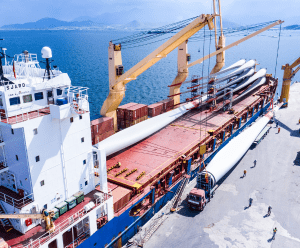
Smart Ports: Harnessing digital technologies for multimodal efficiency

Over 80 percent of global trade's goods are transported by sea. Ports are the heart and soul of this global economy, especially as international trade continues to grow daily.
However, with this exponential increase in volume comes the added need for improved efficiency, enhanced safety, and reduced environmental impact. Smart ports — digitally connected, data-driven ecosystems — come into play here, optimizing port operations, cutting downtime, and improving overall logistics efficiency.
Smart ports, smarter moves
Smart ports leverage extensively on advanced digital technologies. The Internet of Things (IoT), Artificial Intelligence (AI), blockchain, and big data analytics are some resources that turn regular ports into high-functioning ecosystems. This process is accelerated by increasingly available 5G technology. A more streamlined global trade system comes with the seamless integration of systems across different transport modes — air, sea, rail, and road.
Port infrastructures, vehicles, vessels, and cargo are equipped with smart sensors and AI-powered systems that enable real-time visibility and control of all port operations.
In this age of digital transformation, containers can now have both brains and brawn. In a process referred to as “smartification”, smart containers are reinforced with IoT sensors, GPS, and RFID tags, providing real-time data about cargo movements, temperature, surrounding humidity, and records of container tampering. Stakeholders can hence respond swiftly to any disturbances along the delivery route.
The port of Rotterdam is one such port that uses IoT sensors to reduce bottlenecks and optimize the allocation of resources. Sensors on waste containers and sewer gullies measure the levels and indicate appropriate times to empty them.
The Singapore port also leverages IoT sensors and AI to detect shipping anomalies such as piracy, and reduce the occurrence of such attempts on cargo. This technology has also enabled it to become a world leader in cold chain logistics and time sensitive-cargo, making it a hub for vaccine transport.
Both ports also use automated container number recognition through optical character recognition (OCR) that facilitates traffic management, allowing for smoother operations.
Digital doppelgängers
Virtual replicas, or digital twins, of physical port assets like cranes, ships, and containers function as digital twins simulate scenarios to predict potential failures or delays within the port’s processes. As a result, ports can carry out predictive maintenance, leading to a reduction in costly downtimes.
Countries like Singapore have tapped digital twin technology to manage their complex port operations. Its first fully electric harbor vehicle, the Hydromover, has its own digital twin, and IoT systems simulate the vehicle’s reactions to severe weather conditions like storm surges and thunderstorms in real time. Sensors are also installed to oversee battery performance, reducing downtime, and extending asset life.
AI, take the wheel
Port operations are growing increasingly automated. In many international ports today, AI systems manage ship arrival timings and cargo allocations by processing and interpreting a sea of data, accurately predicting vessel arrival timings, and optimizing berth allocations. As such, waiting times are reduced, and cargo deliveries are more efficient.
Cloud-controlled autonomous vehicles are also quickly becoming fixtures in smart ports, leading to faster and more precise loading, and unloading. The adoption of cloud-controlled autonomous vehicles has proved invaluable for China’s Tianjin port, which now runs on 5G, in partnership with Huawei and China Mobile. It tracks more than 20 million shipment containers a year.
Hamburg’s port, a pioneer in smart port development, utilizes an IoT approach to optimize traffic management, coordinating the movement of trucks, trains, and cranes across all aspects of harbor management. This ensures goods are transported efficiently across multiple transportation modes, aligned with ship arrival timings. Its port authority has installed more than 300 roadway sensors to monitor traffic within the port area, and these sensors assist in giving drivers traffic and parking information through digital signs and mobile applications.
These sensors are also installed within waterways, tapping on radar and automatic identification systems to optimize vessel movements. They even work together with IoT systems to implement solutions should traffic disruptions occur when bridge closures in the surrounding area occur.
Blockchain anchors down
Imagine a world where every transaction could be recorded and maintain its unfailing accuracy forever. All that is now possible with blockchain technology.
Blockchain enhances the transparency and security of port operations by powering smart contracts. This allows for faster and more secure payments that reduce fraud risks. With blockchain, documentation processes are also streamlined and reduced. More cargo can be cleared faster with less paper pushing.
Blockchain solutions are utilized in the port of Singapore to streamline administrative processes and increase trust levels among its stakeholders. The Secured Maritime Application Realtime Transactions (SMART) platform allows for tamper-proof certificates that replace physical ones lead to global savings and significant reductions in disputes, fraud risks, and delays in trade.
Greener pastures
A significant goal in using AI systems is the adoption in sustainable operations within the logistics sector. Many smart ports are making the shift toward integrating sustainable technologies that reduce carbon emissions and energy consumption. Port equipment is electrified wherever possible, and wind and solar energies are tapped for more sustainable energy sources. AI also allows for the creation of a tailored automated energy management system designed to increase the port's energy efficiency.
Ports like those in Los Angeles have invested heavily in zero carbon emissions equipment, including machinery and vehicles like electric cranes and trucks. Singapore, partnering with Microsoft, is tapping on AI and digital twin technology to minimize unnecessary vessel and vehicle emissions.
Rotterdam port is developing a planning tool, Plato, that leverages AI to combine the planning of quay wall inspections with dredging work. As dredging utilizes approximately 10 percent of terminal availability at any one-time, efficient maintenance work allows for lesser terminal downtimes and reduced carbon footprints.
Multimodal mastery
Beyond improving maritime operations, the logistics industry has been increasingly focused on enhancing overall multimodal efficiency. With smart ports, the various modes of transportation utilized within supply chain processes, such as ships, trucks, and trains, can interact more effectively.
Within the Asia Pacific region, Hong Kong and Singapore are integrating maritime, road, and air freight operations by adopting digital technologies. Hong Kong’s smart port initiative is heavily invested in real-time cargo tracking, with plans to incorporate AI-based traffic management.
The Maritime and Port Authority of Singapore (MPA) has set up the Singapore Maritime Data Hub (SG-MDH), digitalPORT@SG™, and digitalOCEANS™, as the core of the digital port ecosystem, where port services are integrated, and industry partners can collaborate smoothly through a cohesive system.
In this age of digital transformations, ports worldwide have stepped into the next phase of logistics management, with IoT, digital twin technology, and AI leading to advancements in shipping.
As inventions continue evolving, the global supply chain can only increase in its interconnectedness, transparency, and resilience.
Such steps will usher in a new era of multimodal efficiency that not only benefits businesses, but consumers and the environment alike. To stay ahead of the game, we must continuously adapt and overcome to sail closer to a more sustainable global trade ecosystem.
ALSO WORTH READING















 English
English